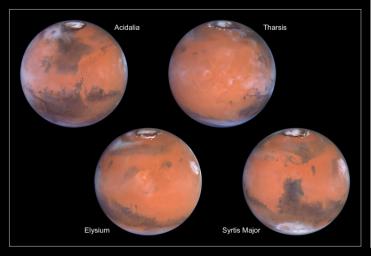Taking advantage of Mars's closest approach to Earth in eight years, astronomers using NASA's Hubble Space Telescope have taken the space-based observatory's sharpest views yet of the Red Planet. NASA is releasing these images to commemorate the second anniversary of the Mars Pathfinder landing. The lander and its rover, Sojourner, touched down on the Red Planet's rolling hills on July 4, 1997, embarking on an historic three-month mission to gather information on the planet's atmosphere, climate, and geology.
The telescope's Wide Field and Planetary Camera 2 snapped these images between April 27 and May 6, when Mars was 54 million miles (87 million kilometers) from Earth. From this distance the telescope could see Martian features as small as 12 miles (19 kilometers) wide.
The telescope obtained four images, which, together, show the entire planet. Each view depicts the planet as it completes one quarter of its daily rotation. In these views the north polar cap is tilted toward the Earth and is visible prominently at the top of each picture. The images were taken in the middle of the Martian northern summer, when the polar cap had shrunk to its smallest size. During this season the Sun shines continuously on the polar cap. Previous telescopic and spacecraft observations have shown that this summertime "residual" polar cap is composed of water ice, just like Earth's polar caps.
These Hubble telescope snapshots reveal that substantial changes in the bright and dark markings on Mars have occurred in the 20 years since the NASA Viking spacecraft missions first mapped the planet. The Martian surface is dynamic and ever changing. Some regions that were dark 20years ago are now bright red; some areas that were bright red are now dark. Winds move sand and dust from region to region, often in spectacular dust storms. Over long time scales many of the larger bright and dark markings remain stable, but smaller details come and go as they are covered and then uncovered by sand and dust.
The upper-left image is centered near the location of the Pathfinder landing site. Dark sand dunes that surround the polar cap merge into a large, dark region called Acidalia. This area, as shown by images from the Hubble telescope and other spacecraft, is composed of dark, sand-sized grains of pulverized volcanic rock. Below and to the left of Acidalia are the massive Martian canyon systems of Valles Marineris, some of which form long linear markings that were once thought by some to be canals. Early morning clouds can be seen along the left limb of the planet, and a large cyclonic storm composed of water ice is churning near the polar cap. See also PIA01589.
The upper-right image is centered on the region of the planet known as Tharsis, home of the largest volcanoes in the solar system. The bright, ring-like feature just to the left of center is the volcano Olympus Mons, which is more than 340 miles (550 kilometers) across and 17 miles(27 kilometers) high. Thick deposits of fine-grained, windblown dust cover most of this hemisphere. The colors indicate that the dust is heavily oxidized ("rusted"), and millions (or perhaps billions) of years of dust storms have homogenized its composition. Prominent late afternoon clouds along the right limb of the planet can be seen. See also PIA01590.
The lower-left image is centered near another volcanic region known as Elysium. This area shows many small, dark markings that have been observed by the Hubble telescope and other spacecraft to change as a result of the movement of sand and dust across the Martian surface. In the upper left of this image, at high northern latitudes, a large chevron-shaped area of water ice clouds mark a storm front. Along the right limb, a large cloud system has formed around the Olympus Mons volcano. See also PIA01591.
The lower-right image is centered on the dark feature known as Syrtis Major, first seen telescopically by the astronomer Christian Huygens in the 17th century. Many small, dark, circular impact craters can be seen in this region, attesting to the Hubble telescope's ability to reveal fine detail on the planet's surface. To the south of Syrtis a large circular feature called Hellas. Viking and more recently Mars Global Surveyor have revealed that Hellas is a large and deep impact crater. These Hubble telescope pictures show it to be filled with surface frost and water ice clouds. Along the right limb, late afternoon clouds have formed around the volcano Elysium. See also PIA01592.
Shown here are color composites generated from data using three filters: blue (410 nanometers), green (502 nanometers), and red (673 nanometers). A total of 12 color filters, spanning ultraviolet to near-infrared wavelengths, were used in the observation.

 Planetary Data System
Planetary Data System












